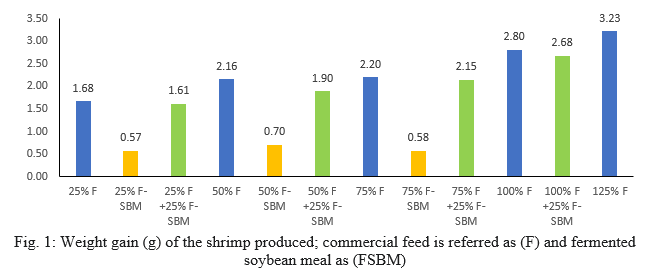NUTRITIONAL CONTRIBUTION OF FERMENTED SOYBEAN MEAL AS A FEED REPLACEMENT FOR THE PACIFIC WHITE SHRIMP Penaeus vannamei
Shrimp farmers have been using fermented soybean meal (FSBM) as a partial replacement for commercial feeds for the pacific white shrimp. However, there are no reports published regarding the use of FSBM as feed replacement. Hence, two 6-week growth trials were conducted in clear water (20 shrimp/tank) and outdoor green water (35 shrimp/tank) systems to determine the biological value. FSBM was produced by first mixing a solution consisted of 0.3g of Lactobacillus and Saccharomyces, 0.15g phytase enzyme, 9g of molasses, and 100ml seawater which was fermented for ~24hours. This was then top coated on pelleted soybean meal (SBM) at ~30% (w/w) of the fermented solution, then was left to dry ferment for ~24 hours. FSBM was then used as a replacement for a commercial feed on an equal protein basis and 12 treatments using varying levels of feed, F-SBM and a partial replacement of the feed with FSBM were developed. Moreover, feed intake was evaluated using both acoustic monitoring and traditional feed consumption as a validation of shrimp (10/tank) intake of the FSBM over a 30 min period. Although it was confirmed that shrimp utilized the FSBM, the acoustic feeding activity and food consumption were significantly higher when fed commercial diet (P-value < 0.05). There was a linear response of shrimp growth with the increase of feed amount (F), however it was noticed that there was no increase of the shrimp growth with the increase of FSBM (Figure 1). Data indicates that the use of FSBM as a single protein source supports only 1/3 of the growth regardless of the amount offered to the shrimp. This study indicates that there is a limited contribution of the FSBM as a single source protein.
